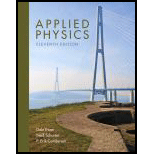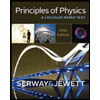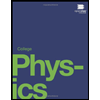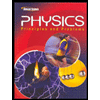
Applied Physics (11th Edition)
11th Edition
ISBN: 9780134159386
Author: Dale Ewen, Neill Schurter, Erik Gundersen
Publisher: PEARSON
expand_more
expand_more
format_list_bulleted
Concept explainers
Textbook Question
Chapter 21, Problem 23RQ
Explain why a fish under water appears to be at a different depth below the surface than it actually is. Does it appear deeper or shallower?
Expert Solution & Answer
Want to see the full answer?
Check out a sample textbook solution
Chapter 21 Solutions
Applied Physics (11th Edition)
Ch. 21.5 - Given so = 1.65 cm and st = 6.00 cm, find f.Ch. 21.5 - Given f = 15.0 cm and st = 3.00 cm, find so.Ch. 21.5 - Given st = 14.5 cm and f = 10.0 cm, find so.Ch. 21.5 - Given st = - 10.0 cm and f = - 5.00 cm, find so.Ch. 21.5 - Given so = 7.35 cm and st = 17.0 cm, find f.Ch. 21.5 - Given ht = 2.75 cm, ho = 4.50 cm, and st = 6.00...Ch. 21.5 - Given ho = 12.0 cm, st = 13.0 cm, and so = 25.0...Ch. 21.5 - Given ht = 3.50 cm. hs = 2.50 cm, and st = 15.5...Ch. 21.5 - If an object is 2.50 m tall and 8.60 m from a...Ch. 21.5 - An object 30.0 cm tall is located 10.5 cm from a...
Ch. 21.5 - Prob. 11PCh. 21.5 - An object 12 6 cm in front of a convex mirror...Ch. 21.5 - What is the height of an image in a truck mirror...Ch. 21.5 - A lift truck has a rear view mirror that is 0.76 m...Ch. 21.5 - Find the focal length of a convex mirror that...Ch. 21.5 - Find the focal length of a mirror that forms an...Ch. 21.5 - Find the focal length of a mirror that forms an...Ch. 21.5 - An image of a statue appears to be 11.5 cm behind...Ch. 21.5 - (a) What is the height of a figurine 7.33 cm in...Ch. 21.10 - Find the index of refraction of a medium for which...Ch. 21.10 - Prob. 2PCh. 21.10 - If the index of refraction of a liquid is 1.50,...Ch. 21.10 - The angle of incidence of light passing from air...Ch. 21.10 - If the critical angle of a liquid is 42.4, find...Ch. 21.10 - If the index of refraction of a substance is 2.45,...Ch. 21.10 - A converging lens has a focal length of 15.0 cm....Ch. 21.10 - An object 2.50 cm tall is placed 20.0 cm from a...Ch. 21.10 - The focal length of a lens is 5.00 cm. How far...Ch. 21.10 - If the distance from the lens in your eye to the...Ch. 21.10 - An object 5.00 cm tall is placed 15.0 cm from a...Ch. 21.10 - An object 4.50 cm tall is placed 18.0 cm from a...Ch. 21.10 - What are the size and location of an image...Ch. 21.10 - What are the size and location of an image...Ch. 21.10 - What is the focal length of a convex lens that...Ch. 21 - Stained glass is an example of a. a transparent...Ch. 21 - A virtual image may be a. larger than the object....Ch. 21 - A real image may be a. erect. b. shown on a...Ch. 21 - Explain the difference between diffusion and...Ch. 21 - Prob. 5RQCh. 21 - Prob. 6RQCh. 21 - Describe the type of images formed by plane...Ch. 21 - Explain the difference between real and virtual...Ch. 21 - Explain the difference between a concave and a...Ch. 21 - Explain the effect of spherical aberration.Ch. 21 - For a mirror of given focal length, how does the...Ch. 21 - For a given object distance from a mirror, how...Ch. 21 - The index of refraction depends on a. the focal...Ch. 21 - Snell's law involves a. the lens equation. b. the...Ch. 21 - Prob. 15RQCh. 21 - Give several examples of total internal...Ch. 21 - Prob. 17RQCh. 21 - Prob. 18RQCh. 21 - Prob. 19RQCh. 21 - What types of images are formed by diverging...Ch. 21 - What types of images are formed by converging...Ch. 21 - How do water waves affect the escape of light from...Ch. 21 - Explain why a fish under water appears to be at a...Ch. 21 - Does light always travel in a straight line?...Ch. 21 - Explain how total internal reflection allows light...Ch. 21 - Under what conditions will a converging lens form...Ch. 21 - Under what conditions will a converging lens form...Ch. 21 - Under what conditions will a diverging lens form a...Ch. 21 - Using 1f=1s0+1si, s0 = 3.50 cm, and si = 7.25 cm,...Ch. 21 - Using 1f=1s0+1si, s0 = 8.50 cm, and f = 25.0 cm,...Ch. 21 - Using M=hih0=sis0, h0 = 6.50 cm, si = 7.50 cm, and...Ch. 21 - If an object is 3.75 m tall and 7.35 m from a...Ch. 21 - An object 43.0 cm tall is located 23.4 cm from a...Ch. 21 - Prob. 6RPCh. 21 - The angle of incidence of light passing from air...Ch. 21 - If the index of refraction of a liquid is 1.44,...Ch. 21 - If the critical angle of a liquid is 45.6, find...Ch. 21 - If the index of refraction of a substance is 1.50,...Ch. 21 - A converging lens has a focal length of 12.0 cm....Ch. 21 - An object 4.50 cm tall is placed 20.0 cm from a...Ch. 21 - The focal length of a lens is 4.00 cm. How far...Ch. 21 - What is the focal length of a convex lens that...Ch. 21 - What is the focal length of a mirror that forms an...Ch. 21 - What are the size and location of an image...Ch. 21 - What is the speed of light passing through a...Ch. 21 - Prob. 18RPCh. 21 - Find the focal length of a concave mirror with an...Ch. 21 - Prob. 20RPCh. 21 - Tamera uses a concave mirror when applying makeup....Ch. 21 - A convex security mirror has a radius of curvature...Ch. 21 - Prob. 3ACCh. 21 - Diamonds are cut to take advantage of internal...Ch. 21 - A photographer uses a 60.0-mm lens. (a) How far...
Additional Science Textbook Solutions
Find more solutions based on key concepts
Description of Motion:
Tutorials in Introductory Physics
Answer the following questions for the position of the Moon shown in Figure 1.
Which Moon phase would an Earth...
Lecture- Tutorials for Introductory Astronomy
A satellite in a geosynchronous circular orbit is 42,164.0 km from the center of Earth. A small asteroid collid...
University Physics Volume 1
The classical picture of the hydrogen atom has the electron or-biting 0.0529 nm from the proton. Whats the elec...
Essential University Physics (3rd Edition)
Conversations with astronauts on the lunar surface were characterized by a kind of echo in which the earthbound...
College Physics
Which features of archaeans suggest they are more closely related to eukaryotes than to bacteria?
Conceptual Integrated Science
Knowledge Booster
Learn more about
Need a deep-dive on the concept behind this application? Look no further. Learn more about this topic, physics and related others by exploring similar questions and additional content below.Similar questions
- Explain why a fish in a spherical goldfish bowl appears larger than it really is.arrow_forwardExp1ain why an object in water always appears to be at a depth shallower than it actually is?arrow_forwardHow would a fish see the above-water world when looking up at various angles? (Hint: Think in terms of the critical angle and the cone of light coming in from above the water in reverse-ray tracing.)arrow_forward
- The level of water in a clear, colorless glass can easily be observed with the naked eye. The level of liquid helium in a clear glass vessel is extremely difficult to see with the naked eye. Explain. Hint: The index of refraction of liquid helium is close to that of air.arrow_forwardWill the focal length of a lens change when it is submerged in water? Explain.arrow_forwardA ring with a colorless gemstone is dropped into water.The gemstone becomes invisible when submerged. Can it be a diamond? Explain.arrow_forward
- Consider a common mirage formed by superheated air immediately above a roadway. A truck driver whose eyes are 2.00 m above the road, where n = 1.000 293, looks forward. She perceives the illusion of a patch of water ahead on the road. The road appears wet only beyond a point on the road at which her line of sight makes an angle of 1.20 below the horizontal. Find the index of refraction of the air immediately above the road surface.arrow_forwardUnreasonable Results A boy has a near point of 50 cm and a far point of 500 cm. Will a —4.00 D lens correct his far point to infinity?arrow_forwardA nearsighted man cannot see objects clearly beyond 20 cm from his eyes. How close must he stand to a mirror in order to see what he is doing when he shaves?arrow_forward
- Explain why an object in water always appears to be at a depth shallower than it actually is? Why do people sometimes sustain neck and spinal injuries when diving into unfamiliar ponds or waters?arrow_forwardThe accommodation limits for a nearsighted persons eyes are 18.0 cm and 80.0 cm. When he wears his glasses, he can see faraway objects clearly. At what minimum distance is he able to see objects clearly?arrow_forwardDuring LASIK eye surgery (laser-assisted in situ keratomileusis), the shape of the cornea is modified by vaporizing some of its material. If the surgery is performed to correct for nearsightedness, how does the cornea need to be reshaped?arrow_forward
arrow_back_ios
SEE MORE QUESTIONS
arrow_forward_ios
Recommended textbooks for you
 Principles of Physics: A Calculus-Based TextPhysicsISBN:9781133104261Author:Raymond A. Serway, John W. JewettPublisher:Cengage Learning
Principles of Physics: A Calculus-Based TextPhysicsISBN:9781133104261Author:Raymond A. Serway, John W. JewettPublisher:Cengage Learning College PhysicsPhysicsISBN:9781938168000Author:Paul Peter Urone, Roger HinrichsPublisher:OpenStax College
College PhysicsPhysicsISBN:9781938168000Author:Paul Peter Urone, Roger HinrichsPublisher:OpenStax College University Physics Volume 3PhysicsISBN:9781938168185Author:William Moebs, Jeff SannyPublisher:OpenStax
University Physics Volume 3PhysicsISBN:9781938168185Author:William Moebs, Jeff SannyPublisher:OpenStax An Introduction to Physical SciencePhysicsISBN:9781305079137Author:James Shipman, Jerry D. Wilson, Charles A. Higgins, Omar TorresPublisher:Cengage Learning
An Introduction to Physical SciencePhysicsISBN:9781305079137Author:James Shipman, Jerry D. Wilson, Charles A. Higgins, Omar TorresPublisher:Cengage Learning Glencoe Physics: Principles and Problems, Student...PhysicsISBN:9780078807213Author:Paul W. ZitzewitzPublisher:Glencoe/McGraw-Hill
Glencoe Physics: Principles and Problems, Student...PhysicsISBN:9780078807213Author:Paul W. ZitzewitzPublisher:Glencoe/McGraw-Hill Physics for Scientists and Engineers: Foundations...PhysicsISBN:9781133939146Author:Katz, Debora M.Publisher:Cengage Learning
Physics for Scientists and Engineers: Foundations...PhysicsISBN:9781133939146Author:Katz, Debora M.Publisher:Cengage Learning

Principles of Physics: A Calculus-Based Text
Physics
ISBN:9781133104261
Author:Raymond A. Serway, John W. Jewett
Publisher:Cengage Learning

College Physics
Physics
ISBN:9781938168000
Author:Paul Peter Urone, Roger Hinrichs
Publisher:OpenStax College

University Physics Volume 3
Physics
ISBN:9781938168185
Author:William Moebs, Jeff Sanny
Publisher:OpenStax

An Introduction to Physical Science
Physics
ISBN:9781305079137
Author:James Shipman, Jerry D. Wilson, Charles A. Higgins, Omar Torres
Publisher:Cengage Learning

Glencoe Physics: Principles and Problems, Student...
Physics
ISBN:9780078807213
Author:Paul W. Zitzewitz
Publisher:Glencoe/McGraw-Hill

Physics for Scientists and Engineers: Foundations...
Physics
ISBN:9781133939146
Author:Katz, Debora M.
Publisher:Cengage Learning
Convex and Concave Lenses; Author: Manocha Academy;https://www.youtube.com/watch?v=CJ6aB5ULqa0;License: Standard YouTube License, CC-BY